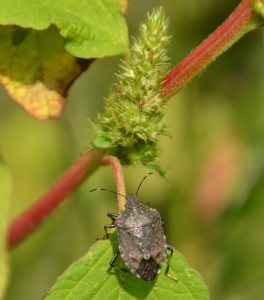
Since mid-April we’ve been monitoring Brown Marmorated Stink Bug, Halyomorpha halys (BMSB) in 8 counties of Eastern New York using the standard black Tedders trap and aggregation pheromone. If you’ve been following BMSB trap captures using EDDMaps/BMSB you’ve found that none of our monitored sites have been at or above the action threshold for this insect this season. Our scouting and trapping observations have shown very few BMSB across the state.
The adult Brown Marmorated Stink Bug overwintered successfully in the Hudson Valley. However, we believe that low levels of survival occurred in woodland habitat, with surviving populations emerging into the environment primarily from rural, suburban and urban structures and homes. That said, it appears from our field observations along the perimeter of vegetable fields and orchards, very low population levels are now present, resulting in reduced 1st generation development this season compared to the previous 4 years. We are seeing what appears to be a few 1st generation adults now making their way to structures. As we move into August its likely we will begin to see an increase of 1st generation adults in traps with adults moving toward overwintering sites beginning early September.
In sites with historically high populations of BMSB, we typically see habitat of deciduous forests and hedgerows with trees such as Ailanthus altissma (Tree of Heaven), Locust, Ash, Sugar Maple and Sumac as well as weed hosts such as late season Redroot Pigweed. In surveying these trees we have seen no BMSB feeding on foiage or seed pods, no presence of adult, egg clusters or nymph. During our monitoring of Sunflower and Jalapeno pepper, which are favored agricultural plants of BMSB, we have seen no evidence of the insect on these plants in Orange and Ulster Counties to date.

Trap Capture and Scouting Threshold: Although trap numbers of BMSB are very low we continue to recommend that trap placement and monitoring, with scouting of orchard edge should continue throughout the remainder of the season on to the end of late variety harvest.
Using the ‘Provisional Trap Threshold’, if BMSB adult captures exceed 10/ trap per week, or if the insect is observed on the tree, using 1 BMSB per 100 feet of perimeter orchard linear row, applications for management of BMSB using should be made. Employ the first available window using one of the most effective insecticides that will best fit your harvest schedule.
The list of the most effective insecticides for BMSB management is found using this link. NYS labeled insecticides effective for use against the BMSB are available in four major classes including pre-mix formulations.
Of the pyrethroid group, efficacy studies have shown bifenthrin to one of the most effective insecticides for use against the BMSB. At this point in the season, early blocks can be managed using Bifenthrin, Danitol and Lannate (14d PHI). Blocks that have threshold levels of BMSB near harvest can use Leverage 360. It is very effective against both nymphs and adults with a 7d PHI. Boarder applications to cover most vulnerable blocks should be considered if populations begin to increase.
Bifenthrin received an emergency exemption use permit (Section 18) to control brown marmorated stink bug (BMSB) on apples, peaches, and nectarines in Columbia, Dutchess, Orange, and Ulster Counties of NY. NY Authorization letter (PDF) and Labels specific for the Section 18 Exemption for bifenthrin use in NY can be found here (2016 only)
Brigade WSB
Bifenture EC; Section 18 label
Bifenture 10DF; Section 18 Label
Regardless of the product used, a maximum of 0.08 to 0.2 lb[AI]/acre/season is allowed, with no more than 0.5 lb a.i./acre applied per year with multiple applications made at a minimum of 30 day intervals; a restricted entry interval (REI) of 12 hours and pre-harvest interval (PHI) of 14 days must be observed. When applying either of these materials for BMSB control on apples, peaches, or nectarines, growers must have possession of the Section 18 label.

Follow-up (Aug. 2nd, 2016):
With regards to weather related influences: the knee jerk response to this seasons dramatic temperature swings would suggest that the week of Dec 1st-7th (very warm week in the 70F’s ), coupled with Feb 14th (>-10F) and April 5-6 (-15 to -8F) were likely determining factors leading up to BMSB decline in the region.
The mid-Atlantic BMSB populations have increased over last season. It may be that the April temps were the most influential factor as BMSB began to metabolize sugars creating solutes for ice crystallization, decreasing cold hardiness and increasing the potential for mortality .
Our ‘urban populations’ were present but from the forest overwintering studies done by USDA (Leskey et al) they are considerably larger then the urban population and give rise to the agriculturally damaging numbers of insects.
Although BMSB are present, they may need a critical mass to really build, which we have not seen north of Columbia County to date.
The influence of weather I believe plays an important role in maintaining relatively moderate BMSB populations in our region. While the contribution of parasites, predators and entomophagous fungi may be assisting in lowering the numbers of BMSB in the Northeast, especially in years where weather takes its toll on insects. We have seen this across insect pest populations this season. To better understand this function, we have been setting out BMSB egg masses to determine the level of BMSB parasitism we may have in the Hudson Valley. In yello sticky card placement we have found high levels of Trissolcus species that we are keying to species. Secondarily we are hoping to capture the Asian wasp Trissolcus japonicus if t has ventured into NYS. This parasitoid will certainly become an important part of our management strategies of BMSB in the near future.

